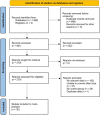Analysis of the screening and predicting characteristics of the house-tree-person drawing test for mental disorders: A systematic review and meta-analysis
- PMID: 36683989
- PMCID: PMC9848786
- DOI: 10.3389/fpsyt.2022.1041770
Analysis of the screening and predicting characteristics of the house-tree-person drawing test for mental disorders: A systematic review and meta-analysis
Abstract
Background: The house-tree-person (HTP) drawing test has received growing attention from researchers as a common projective test. However, the methods used to select and interpret drawing indicators still lack uniformity.
Objective: This study aims to integrate drawing indicators into the process of screening for or classifying mental disorders by conducting a systematic review and meta-analysis of the application of the HTP test.
Methods: A search of the following electronic databases was performed in May 2022: PubMed, Web of Science, Embase, EBSCO, CNKI, VIP, and Wanfang. Screening and checking of the literature were performed independently by two researchers. The empirical studies published on the use of the HTP test in mental disorders and studies providing specific data on the occurrence frequency of drawing characteristics were analyzed. A total of 30 studies were included in the meta-analysis, including 665 independent effect sizes and 6,295 participants. The strength of the association between drawing characteristics of the HTP test and the prevalence of mental disorders was measured by the ratio (OR) with a 95% CI. Publication bias was assessed using a funnel plot, Rosenthal's fail-safe number (N fs), and the trim and fill method.
Results: The results revealed 50 drawing characteristics that appeared at least three times in previous studies, of which 39 were able to significantly predict mental disorders. The HTP test can be divided into the following four dimensions: house, tree, person, and the whole. These dimensions reflect the structure, size, and other characteristics of the picture. The results showed that the greatest predictor of mental disorders was the whole (OR = 4.20, p < 0.001), followed by the house (OR = 3.95, p < 0.001), the tree (OR = 2.70, p < 0.001), and the person (OR = 2.16, p < 0.001). The valid predictors can be categorized into the following four types: item absence, bizarre or twisted, excessive details, and small or simplified. The subgroup analysis showed that the affective-specific indicators included no motion, leaning house, and decorated roof; thought-specific indicators included excessive separation among items, no window, loss of facial features, and inappropriate body proportions; and common indicators of mental disorders included no additional decoration, simplified drawing, very small house, two-dimensional house, and very small tree.
Conclusion: These findings can promote the standardization of the HTP test and provide a theoretical reference for the screening and clinical diagnosis of mental disorders.
Keywords: aiding diagnosis; house-tree-person drawing test; mental disorders; meta-analysis; screening.
Copyright © 2023 Guo, Feng, Ma, Zhang, Fan, Dong, Chen and Gong.
Conflict of interest statement
The authors declare that the research was conducted in the absence of any commercial or financial relationships that could be construed as a potential conflict of interest.
Figures
Similar articles
-
Synthetic House-Tree-Person Drawing Test: A New Method for Screening Anxiety in Cancer Patients.J Oncol. 2019 Mar 26;2019:5062394. doi: 10.1155/2019/5062394. eCollection 2019. J Oncol. 2019. PMID: 31031811 Free PMC article.
-
The House-Tree-Person test is not valid for the prediction of mental health: An empirical study using deep neural networks.Acta Psychol (Amst). 2022 Oct;230:103734. doi: 10.1016/j.actpsy.2022.103734. Epub 2022 Sep 1. Acta Psychol (Amst). 2022. PMID: 36058187
-
Characteristics of House-Tree-Person Drawing Test in Junior High School Students with Depressive Symptoms.Clin Child Psychol Psychiatry. 2023 Oct;28(4):1623-1634. doi: 10.1177/13591045221129706. Epub 2022 Sep 26. Clin Child Psychol Psychiatry. 2023. PMID: 36154491
-
The prevalence of child maltreatment among Chinese primary and middle school students: a systematic review and meta-analysis.Soc Psychiatry Psychiatr Epidemiol. 2020 Sep;55(9):1105-1119. doi: 10.1007/s00127-020-01916-7. Epub 2020 Jul 6. Soc Psychiatry Psychiatr Epidemiol. 2020. PMID: 32632599
-
Effectiveness of Videoconference-Delivered Cognitive Behavioral Therapy for Adults With Psychiatric Disorders: Systematic and Meta-Analytic Review.J Med Internet Res. 2021 Dec 13;23(12):e31293. doi: 10.2196/31293. J Med Internet Res. 2021. PMID: 34898445 Free PMC article. Review.
Cited by
-
Evaluating Children's Drawings as a Means of Expression in Children with Chronic Diseases.Med Arch. 2025;79(2):159-163. doi: 10.5455/medarh.2025.79.159-163. Med Arch. 2025. PMID: 40689283 Free PMC article.
-
Evaluating the Tree Drawing Test Depression Assessment Scale for adolescent depression screening.Sci Rep. 2025 Jul 1;15(1):20984. doi: 10.1038/s41598-025-99254-8. Sci Rep. 2025. PMID: 40594844 Free PMC article.
-
Graph learning based suicidal ideation detection via tree-drawing test.Front Psychiatry. 2025 Jul 18;16:1617650. doi: 10.3389/fpsyt.2025.1617650. eCollection 2025. Front Psychiatry. 2025. PMID: 40756313 Free PMC article.
-
Predict the writer's trait emotional intelligence from reproduced calligraphy.Sci Rep. 2025 Aug 6;15(1):28717. doi: 10.1038/s41598-025-13318-3. Sci Rep. 2025. PMID: 40770015 Free PMC article.
References
-
- World Health Organization [WHO]. Mental Disorders Fact Sheets. Geneva: WHO; (2019).
Publication types
LinkOut - more resources
Full Text Sources



